#sea level rise
Photo

Cyprus if all the ice melted
107 notes
·
View notes
Text
The 1987 Montreal Protocol, which phased out the production and use of chemicals that were depleting the ozone layer, has long been considered one of the most successful environmental treaties in history. New research finds that the global pact achieved another unforeseen benefit: delaying the melting of Arctic sea ice.
In a study published Monday in the Proceedings of the National Academy of Sciences, researchers from the University of Exeter and Columbia University found that the implementation of the Montreal Protocol is delaying the first ice-free Arctic summer by up to 15 years. That’s because the chemicals banned under the agreement are also potent greenhouse gases.
“Our results show that the climate benefits from the Montreal Protocol are not in some faraway future: the protocol is delaying the melting of Arctic sea ice at this very moment,” Lorenzo Polvani, one of the study’s authors, said in a press release.
The study authors ran a series of climate models based on two different scenarios: one that included levels of ozone-depleting substances that would be expected if the Montreal Protocol never existed, and another accounting for the global treaty. The researchers concluded that the protocol is postponing the first ice-free Arctic summer by a decade or more, and entirely due to the phasedown of ozone-depleting chemicals.
The Montreal Protocol was created to address a hole in the stratospheric ozone layer over the Antarctic. The ozone layer protects the Earth from harmful ultraviolet radiation that causes skin cancer and cataracts in humans. The treaty phased out almost 100 chemicals — including aerosols used in hair spray and other products, refrigerants, and solvents — that were found to be responsible for destroying stratospheric ozone.
Those banned chemicals, collectively called ozone-depleting substances, or ODS, are also potent greenhouse gases, with up to tens of thousands times the global warming potential of carbon dioxide. The report authors estimate that 1 metric ton of avoided ODS emissions leads to 7,000 square meters (more than 75,000 square feet) of avoided Arctic sea loss. By way of comparison, 1 metric ton of carbon dioxide emissions results in about 3 square meters (about 32 square feet) of sea ice loss.
Given the potency of ODSs as a greenhouse gas, the authors are not surprised at this outsize impact on Arctic sea ice levels. “Nonetheless, such a large mitigating impact of the Montreal Protocol on Arctic sea ice loss is remarkable if one keeps in mind that the protocol was aimed at preventing ozone depletion in the Antarctic stratosphere, and little was known of its effect on Arctic sea ice when the protocol was signed,” the authors noted.
According to their projections, the Montreal Protocol has already prevented more than half a million square kilometers (about 193,000 square miles) of sea ice loss. By 2030, that amount will rise to more than 1 million square kilometers, and to 2 million square kilometers of prevented Arctic sea ice loss by 2040.
-via Grist, 5/24/23
#arctic#arctic circle#arctic ocean#arctic ice#sea ice#climate change#global warming#sea level rise#montreal protocol#cfc#hfc#greenhouse gasses#carbon dioxide#if we hurry#we can absolutely buy ourselves the time to save ourselves#as someone constantly looking at good news developments in the environment and green tech I truly believe that#good news#hope
417 notes
·
View notes
Link
The world’s salty, tidal marshes are hotspots of carbon storage and productivity, building up sediments and plant material so they can stay above sea level. Scientists wondering whether it’s possible for wetlands to keep up with rising sea levels have revealed research that shows how salt marshes along the U.S. coast have responded—by building up elevation more quickly over the last century.
From Good News Network
#habitat#habitat preservation#salt marsh#marsh conservation#wetland conservation#hope#good news#sea level rise#climate resiliency#climate change#global warming#climate anxiety#ecoanxiety#ecogrief#environment
590 notes
·
View notes
Text
“Calling some landscapes ‘natural’ and others ‘artificial’ or ‘cultural’ ignores the fact that landscapes are never wholly one or the other,” observes landscape architect Anne Whiston Spirn. In my interviews with Dutch water experts, I often asked them to explain what they meant when they talked about nature. The question typically provoked laughs, then hedging. The Netherlands, they tried to explain, “doesn’t have nature.” As Evers put it:
So we call our floodplains and rivers natural but of course, it’s all managed. And it’s all mapped out and it’s all needs to be within the boundaries. So the line on the map, which shows where we can have a bush or a tree, and the line where it needs to go into grasslands. That’s actually something that they maintain all throughout the floodplains. So, yeah, it’s quite controlled.
Many preferred to use the word as an adjective. One designer said, “So I think …when we talk about nature, what we really mostly talk about are different natural processes and characteristics and qualities that we want to protect, improve, enhance.” By that logic, any project more green than a concrete dike can be justified as natural, from floodplain expansion to grazing pastures to beach nourishment. These are all “nature-based solutions” in the Dutch delta.
41 notes
·
View notes
Text
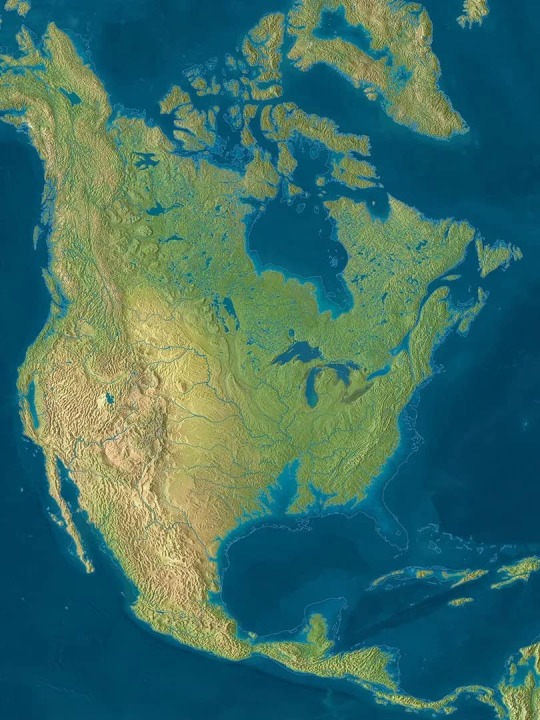
North America 2100. Assumes a sea level rise of 80 m.
[h/t Robert Scott Horton]
* * * * *
The expected effects of a sea-level rise typify the many consequences of a global warming. On the one hand, they are so big we literally can't understand them. If there is a significant polar melting, the Earth's center of gravity will shift, tipping the globe in such a way that the sea level might actually drop at Cape Horn and along the coast of Iceland—I read this in a recent EPA report and found that I didn't really understand what it meant to tip the Earth, through I was awed by the idea. On the other hand, the changes ultimately acquire a quite personal dimension: Should I put in a wall in front of my house? Does this taste salty to you? And, most telling of all, the human response to the problems, the utterly natural human attempt to preserve the old natural way of life in this postnatural world, creates entirely new consequences. The ocean rises; I build a wall; the marsh dies, and, with it, the fish.
Bill McKibben :: "The End Of Nature" p. 117-118
97 notes
·
View notes
Photo
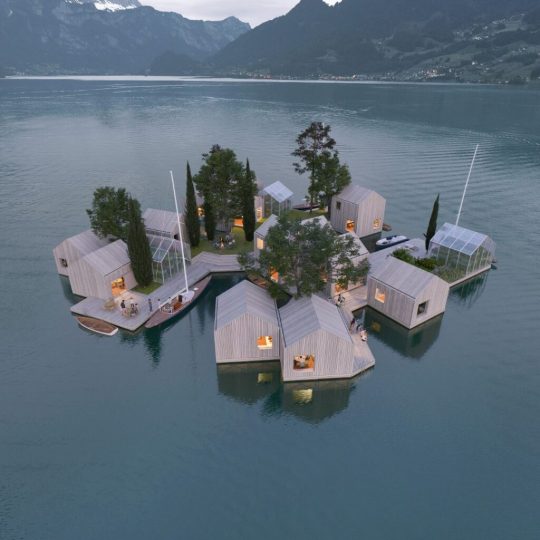
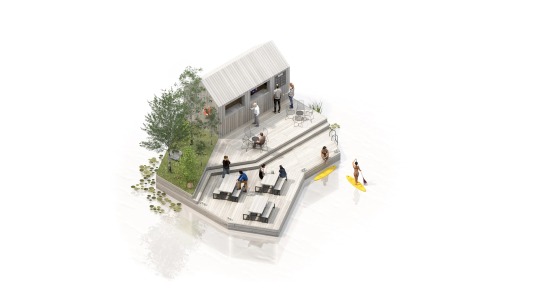
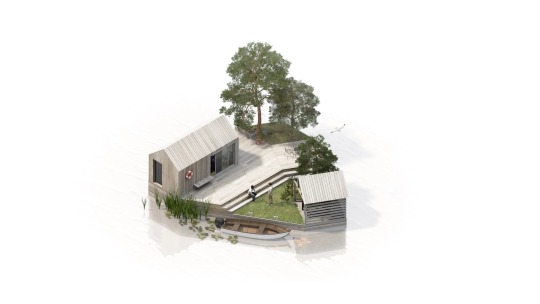


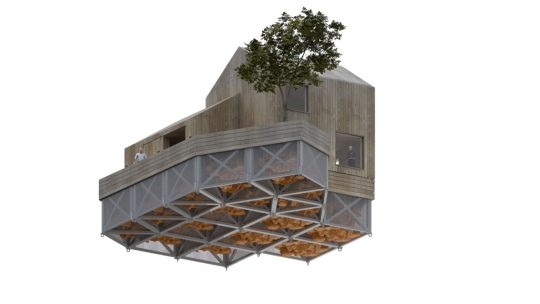

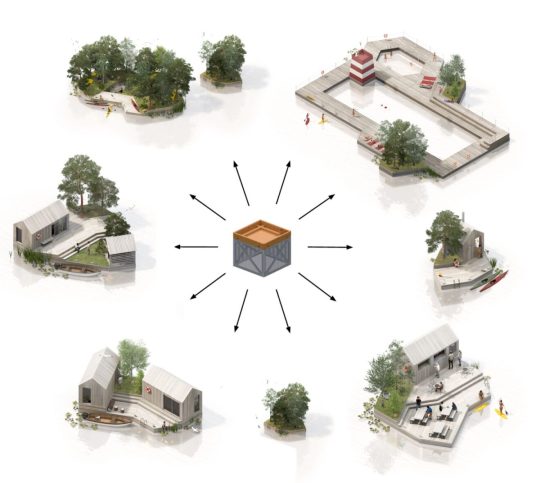
‘Land on Water ‘
A growing acknowledgement of sea level rise and an increased risk of urban flooding has contributed to a sharp increase in interest in building on water but current solutions.
The system is based on simple, flat-pack modules made from reinforced, recycled plastic that can be easily transported around the globe and assembled into countless configurations. Providing a secure floating founda-tion for building housing and infrastructure.
The system was inspired by gabion construction, an ancient technology which utilises mesh cages filled with rub-ble to create extremely sturdy, low cost foundations. In this case the concept is inverted; and the modular ‘cages’ are filled with locally sourced, upcycled floatation supporting the weight of any structure built on top. This has the unique advantage that floatation can be added or adjusted at any time if weight is added above.
Developed by the Danish Maritime Architecture Studio ‘MAST’ with the support of Hubert Rhomberg and venture studio ‘FRAGILE’
Photorealistic visualisations by KVANT-1
#art#design#urban#architecture#eco-friendly#sustainability#land#water#floatinghouse#sea level rise#climate change#flat-pack#module#recycling#modularhouse#prefabhouse#gabion#MAST#hubert rhomberg#fragile#concept#nature
224 notes
·
View notes
Text
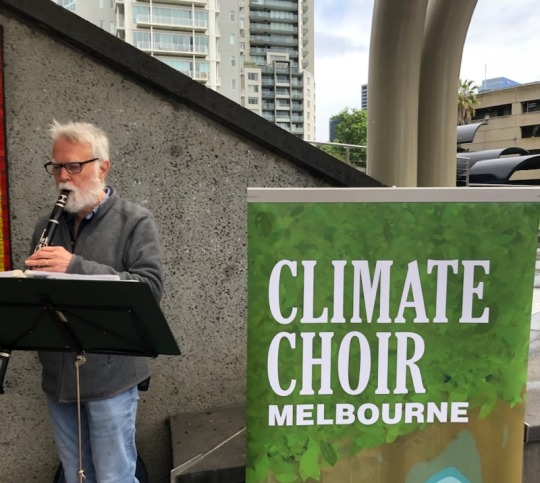
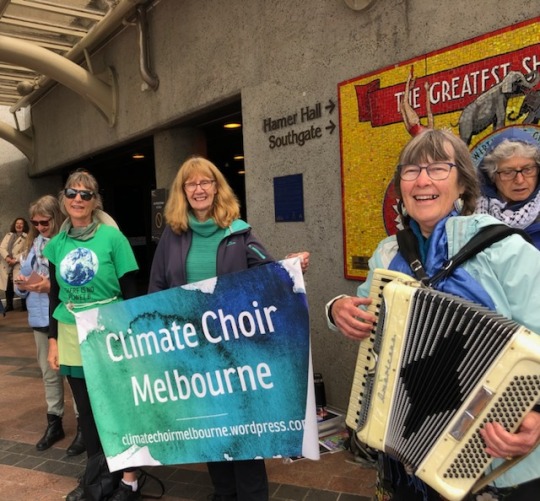
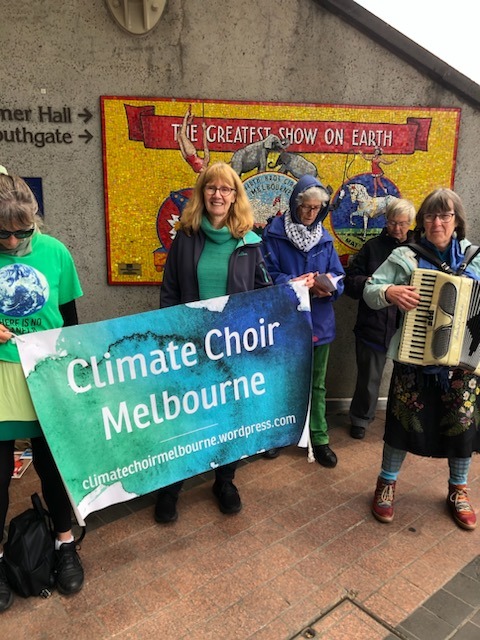
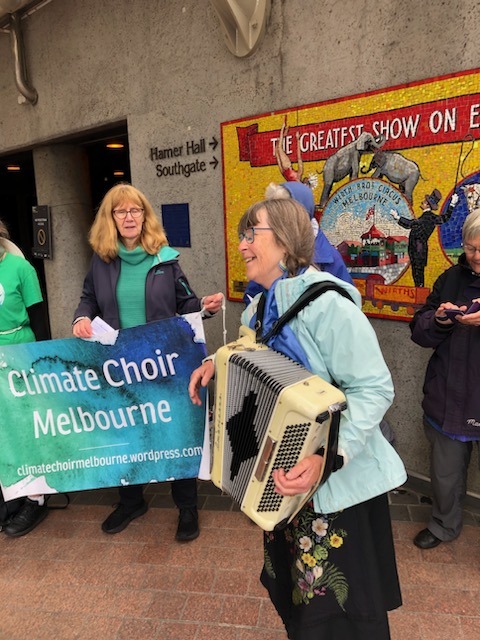
A joyful and effective means of spreading your urgent message. Start up a Climate Choir in your community.
#climate choirs#jail climate criminals#we want climate action now#climate change#cambio climático#climate crisis#prepare for climate change#greenwashing#big oil#fossil fuel industry#plastic#climate washing#floods#climate activism#calentamiento globa#medio ambiente#IPPC#climate hope#sea level rise#late stage capitalism#victims of capitalism#klimakatastrophe#klimawandel#changement climatique#qihou bianhua#izmeneniye klimata#cambiamento climatico#気候変動#जलवायु परिवर्तन#jalavaayu parivartan
24 notes
·
View notes
Text
So much damn life giving water!
9 notes
·
View notes
Text
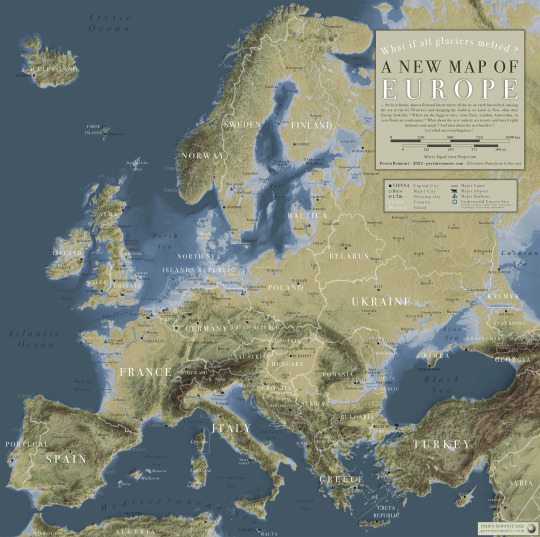
A New Map of Europe: What if all Glaciers on Earth Melted?
19 notes
·
View notes
Photo

Netherlands if sea level were 1 meter higher.
2K notes
·
View notes
Text





Lisa Ericson 🎨🖌 @aqualisa
Territorial, 2023, acrylic on wood panel.
19 notes
·
View notes
Note
Is it true some parts will be under water in 2025? I'm kinda of worried cause someone told me about it bc it was on the news
Eh, not really. Like, technically, but that's a very dramatic way to put it.
What that person told you about was probably this prediction, which says that some roads on some of the Florida Keys might be underwater by 2025.
Does that suck? Yes. But it's also pretty limited in scope.
(And by the way, that's probably not "underwater all the time." There will probably be a number of years of "the roads will be underwater at high tide specifically." I can't currently find a source on this, but that's how tides work, and the Florida Keys article does specifically mention them as a main problem.)
The areas in danger first are pretty universally small, very low islands. Actually, a dozen or so small islands have already gone underwater in the Pacific Ocean, but very importantly, none of those islands were inhabited.
They were mostly small reef islands (that is, the entire island is exposed coral reef detritus) and other uninhabited shoals. Mostly, they were so small scientists had to check old satellite images to even figure out that they disappeared. Literally, we're talking about chunks of land that are just 100 square meters/300 square feet. Again, not great, but still very limited in scope.
As this Live Science article thankfully explains, it's pretty unlikely that any countries at all will disappear before 2100.
Also, just because land is below sea level doesn't mean it will be underwater, and there are very real steps we can take to defend a lot of endangered cities/islands.
For example:
Much of the Netherlands is already below sea level, but the country isn't disappearing, because the Dutch have put a lot of work into building and maintaining coastal defenses.
Multiple surveys (including the one that found the missing islands in Micronesia) also found that not all low-lying islands are vulnerable to erosion and flooding. This is because many islands are protected by mangrove forests, lagoons, or both
Mangrove reforestation in particular is genuinely a super effective anti-flooding strategy that is being deployed pretty widely, and is expected to increase a lot in the coming years. Mangroves are effective at not only preventing short-term flooding, but also mitigating sea-level increases (in part by preventing erosion)
Some islands, esp Pacific Islands, have actually grown during the past couple decades, not shrunk. It really depends on what the island is made up of. Not all land is automatically doomed
You can read more about how sinking countries are fighting back here, and the lessons we can learn from them:
-via Time, June 13, 2019
And finally, and this is good news for reasons I'll explain in a second:
Some of the largest and wealthiest cities in the world are at the top of the danger list. (Note: the predictions at that link are based on some fairly severe warming predictions. They do NOT necessarily reflect what's going to happen or when.)
The cities that are going to be in danger the soonest (still away btw) include New York, London, San Francisco, Tokyo, and Dubai. Lots of very rich people in those cities! Who would really like to not have to move (any of their ten different homes lol)
So, flooding aside, we're going to (by necessity) get a lot better at figuring out the quickest, cheapest, most scalable, and most effective types of coastal defenses real fast.
Are rich countries going to be way more able to get strong coastal defense systems up quickly? Yes. Does that suck? Sure fucking does!! But these solutions don't all require a lot of money or tech to implement, even at a large scale, especially when it's local communities driving the effort.
And, importantly, when rich countries pour a ton of money into figuring this out, that will hugely expand our understanding of what techniques work best, why, and how best to deploy them in different situations. Unlike physical structures, that's valuable knowledge that can be shared very, very widely.
And any technology that comes out of this is going to work like solar panels and other green energy: as more people use it, it will get cheaper and cheaper. Probably really quickly.
So, all told, no one's going to be swallowed up in the next few years. We have time to work on this and a lot of people are already doing so.
Mostly, experts predict that the first wave of large-scale issues will be happening around 2050.
Three decades doesn't sound like enough time, in the face of something like this. But you know what? Responses to climate change are speeding up exponentially, and different types of responses are multiplying and magnifying each other.
We went from inventing flight to landing on the moon in just 66 years.
I wouldn't count us out of the climate change fight yet.
(...I wouldn't count on retiring to Florida either, though)
#Anonymous#sea level rise#ocean#micronesia#pacific islander#mangrove#flood#flood mitigation#ask#me#hope#it does suck but I also really do think there is hope#this post was supposed to be like 2-3 paragraphs how did it turn into an entire essay#I have too many words disease#too much nuance#hope yall appreciate the extra context lol
292 notes
·
View notes
Text
'Sea Level Rise' - Fine Art Photography Self Portrait By Anya Anti

#fine art photography#anya anti#sea level rise#photographers on tumblr#women photographers#female photographers#photography#professional photography#professional photographers#portraiture#self portraiture#self portrait#female artists#female portraiture#female portrait#photography blog#photoblog#photo-art-lady#portrait of a woman#ecology#ecosystem#conservation#environment#global warming#climate crisis#climate change#climate catastrophe#climate#climate action#ecologic intervention
9 notes
·
View notes
Photo




The Country That Drowned,
The climate crisis is no longer just the future It takes place now and here. It demands human life and it destroys the future of children. South Sudan is experiencing severe floods in its fourth year, which is a direct consequence of climate change. 800,000 people have lost their homes to the water masses, and every day that number is getting bigger.
The roads are washed away along with crops, cattle, clean water and toilets. Emergency aid in the form of food and medicine cannot emerge and people are fighting across the dry land against poisonous snakes and crocodiles.
In 1991, the year he graduated, Grarup won the Danish Press Photographer of the Year award, a prize he would receive on several further occasions. In 1993, he moved to Berlin for a year, working as a freelance photographer for Danish newspapers and magazines.
During his career, Grarup has covered many wars and conflicts around the world including the Gulf War, the Rwandan genocide, the Siege of Sarajevo and the Palestinian uprising against Israel in 2000 and latest Ukraine and the climate changes have had his focus.
Jan Grarup / StudioMadebygrarup
#art#photography#soudan#africa#climate change#climate crisis#human rights#humanity#flood#underwater#sea level rise#jan grarup#Black and White#poverty#migration#climate migration#BIFA#BIFA2022
70 notes
·
View notes
Text
Scientists Struggle to Understand Why Antarctica Hasn’t Warmed for Over 70 Years Despite Rise in CO2 – The Daily Sceptic
#science#climate change#global warming#climate hoax#climate activism#scientific propaganda#antarctica#sea level rise#climate propaganda#scientific consensus#trust the science#propaganda
26 notes
·
View notes
Photo






Green Water Village, Miami, Florida, USA,
The project of the new floating village is conceived as a series of artificial islands: these are juxtaposed in a free, irregular, and sequential way, connecting Miami's coast / Legion Park with Picnic Island.
These are individual floating artificial islands (empty caissons technology), irregular hexagonal polygons, all the same but juxtaposed to form an irregular and organic network, opening different paths and views towards the interior spaces and towards the Miami bay. Each single artificial island houses a prefabricated house in metal, wood and glass, on one level or on two floors depending on the type of dwelling.
The aggregation of the islands-houseboats creates small ports for the landing of individual boats, while a continuous and sinuous wooden path connects all the units. The spaces and houses are enriched and characterized by spaces of relationship in which the theme of green is predominant: they are glass and metal cages with an irregular shape that host relaxing and meeting garden spaces that make the floating village. New technologies for capturing rainwater and humidity characterize these iconic volumes, and wind turbines and masts are positioned on their tops.
Gabriele Filippi Architect,
Arch Out Loud’s Miami Floating House Competition
#art#design#architecture#floating house#miami#florida#green#village#islands#polygon#hexagon#prefab#millwork#houseboat#gardens#landscaping#climate change#sea level rise#gabriele filippi#archoutloud#competition
107 notes
·
View notes